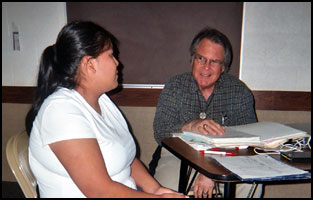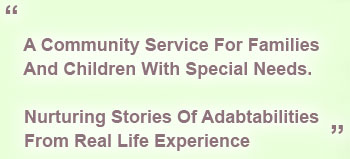INTRODUCTION TO OUR PRACTICES
____
Collaborative Ways to Locate and
Use Family and Community Resources
This writing is a resource for families, schools, neighborhoods and others to use to assist the special-needs community. Our approach is to suggest an interdisciplinary team experience, if needed, which elicits resources from the children themselves, from their families and from their communities. These multi-skilled teams already exists in the community in many forms.
 We thank the families we have encountered in pursuit of this approach. They have contributed to our knowledge by the ways in which they re-frame their challenges and by their novel survival strategies. We hope this resource honors the theories, experience, doggedness and creative coping of these families of special needs children.
We thank the families we have encountered in pursuit of this approach. They have contributed to our knowledge by the ways in which they re-frame their challenges and by their novel survival strategies. We hope this resource honors the theories, experience, doggedness and creative coping of these families of special needs children.
We offer these resources in the service of aspiring the understanding of the disability experience. We suggest our resource here is not merely a box of solutions to apply in a case-by-case way. Rather, the following advice should be used to open the thinking and possibilities of each person involved by using the expertise of parents and caregivers in generative or therapeutic conversations.
Processes and outcomes we desire:
- Dealing with complexity theory.
- Talking in order to connect, and to support a sense of belonging.
- Understanding risks and protections around the child, family and community using a biopsychosocial and cultural model.
- Targeting resources and linking with them.
- Coping and achieving a sense of coherence for child and family.
| [Back to Top] |
Don’t feel you need to read this entire text to get started. Pick and choose. Refer to the abstract from each section or the main headings in the text. Click links to whatever you feel may either get you started or get you unstuck. Or, jump to whatever strikes you as an interesting idea. Also, you don’t have to do all of the outlined steps. You may only need to know how to get a core team started, or you may only want to see how we construct our health plan. Perhaps “Solution Focused Practices,” or, why we use genograms, or, what a physician might do when evaluating the child, will pique your interest.
These web site materials are in the public domain and promoted by the ABLE Program, and you may use them freely. We ask only that you cite their origin if you do use them. You are welcome to change “ABLE Program” references and other wording to serve your needs. The many handouts on this web site focus on relationships and interactions. They apply to various levels of relations in the interactive space between and among the child, family and helpers within diverse community agencies.
Case Studies – Case study as a heading is typically an anecdote or case explanation and will appear throughout the texts giving examples to clarify the discussion. Other Tools appear in these highlighted sections eg. in Part I we present how a letter might be used for parents and children and in Part II an anecdotal Tool on how one might revise a story giving a new name to exceptions to the problem so a more preferred story might be performed.
Many interdependent forces affect the child’s and the family’s behavior and the outcome of the teamwork with ABLE. Our approach is to gain biopsychosocial and cultural understanding of our clients’ situations; from this, multiple views of the problem and many possible solutions arise.
The four parts of this web resource are continuous and sequential. However, each part stands alone, as well. Each of the four parts is preceded by its own introductions, which are located above.
| [Back to Top] |
Part I: Shared Conversations – When a family comes to us, we attempt to understand, acknowledge and respect their unique experience.
Part II: Sharing Mindful Talk – We assess, from multiple viewpoints, strengths and challenges facing the child and family.
Part III: Child-Family Connections -Taking Action Together – We look at ways to connect the child to the larger community and to the resilience within that child and family.
Part IV: Narative Tools for Building Adaptive Identities – We attempt to help the child and family achieve greater meaning from their lived experience.
We assume that readers of this resource have already tried more traditional ways of understanding and more traditional treatment interventions for special-needs children and their families. Such traditions may include social learning theories, behavior management, as well as dynamic and the more traditional play forms of practice. Our own attempts at intervention are based on eliciting from the child and family strengths and competencies, social supports, and stories of survival and thriving that may be used in conduction with more traditional ways of helping. We suggest that our methods are within the scope of best multicultural and resiliency practices, and when used in conjunction with mainstream ideas, may bring positive, synergistic outcomes.
We don’t change families, families change themselves. But we offer our clinical experience, as well as the evaluation of social science outcome research (that informs our practices), which suggests (Lambert, M.J., 1994) factors common to the client and his/her environment, along with relationship-enhanced practices and methods which suggest optimism, hope, expectancy, and determine most of the positive change that families will experience. Our model of care and helpful methods of inquiry which finds strengths and resources to accomplish the client’s goals, engages with their personal theory of mind and frames of reference, and helps to uncover distinctions and discernments which promote new ways of thinking and positive changed outcomes.
The four parts of this web resource reflect the ABLE philosophy of building collaborative and consultative teams that promote a client’s abilities and support behavioral resilience coming from flexible and adaptive learning environments.
| [Back to Top] |








Social Networks
Follow Us